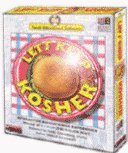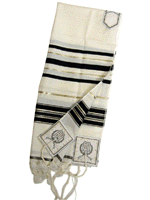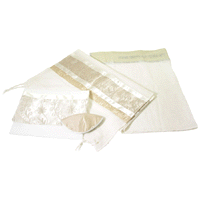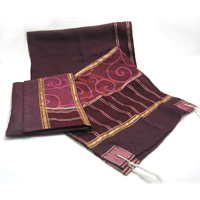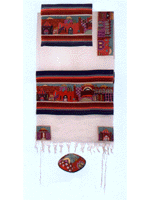|
Living Jewish: Jewish Attire
 A Mazor Guide for Jewish Attire, Jewish Clothes, Jewish Apparel A Mazor Guide for Jewish Attire, Jewish Clothes, Jewish Apparel
Shabbat Clothes, Shabbat Robes, Shabbat
Attire, Shabbat Children's Clothes
Chatan (Chosson) Outfits, Jewish Bride Dresses, Jewish Mother of the
Bride Dresses Bar Mitzvah Attire, Bar Mitzvah Clothes, Israeli
T-shirts, Israeli fashions and more.
Shabbat Attire: Dressing Up for the Holy Day!
Just as you will find in every Jewish observant household a double set of dishes
and pots - the one designated for use for dairy products, the other
for meat and poultry, so will most observant Jewish households, poor
and rich, sport two wardrobes - the one for everyday use, the other
for Shabbat and Holidays.
Growing up, I remember the semi-annual event of buying shoes. At the
eve of every Pesach (Passover) and Rosh Hashannah, new shoes were
purchased. The new pair would be designated as the "New Shabbat
Shoes" and the six month old pair purchased would be demoted to
everyday use. The third pair which until now worn daily was thrown
away or given to charity if still in decent shape.
Observant Jews are an eclectic people, and of course it is
misleading to lumped into one group. Differences are conspicuous
when observing the Shabbat attire of orthodox Jews. Many Chassidic
men wear special hats (Shtreimel) and coats on Shabbat. The men in
modern orthodox community in Israel on the other hand, are often
clad in white Shabbat shirts and either black or khaki pants.
Amongst the "Black Hat" yeshiva crowd, the differences are more
subtle. Only the ones with a real keen eye and an understanding of
the culture can see the difference between the Shabbat and everyday
hat or suit. Chassidic women in especially of Hungarian decent may
often be seen wearing a white apron on Shabbat, while the modern
orthodox may avoid wearing sneakers and other sport wear (Jeans and
the like) and adorn more formal attire.
Broadly generalizing, the delineation between Shabbat and Daily
wardrobes are more pronounced in communities that are to the center
or right of center religiously speaking. A Chassidic young or old
man will never be caught wearing sandals on Shabbat, while a modern
orthodox males are way more lax.
| Jewish
Garb - Jewish Dress - A Glossary (Click on
the images to enlarge) |
 Bekishe: A bekishe is a long black
silk (or for those seeking more affordable - polyester)
coat worn by Chasidic Jews. Mostly the bekishe is worn
on Shabbat, Jewish holidays and for Jewish celebrations
such as weddings and bar mitzvahs. Bekishe: A bekishe is a long black
silk (or for those seeking more affordable - polyester)
coat worn by Chasidic Jews. Mostly the bekishe is worn
on Shabbat, Jewish holidays and for Jewish celebrations
such as weddings and bar mitzvahs. |
 Gartel: Yiddish for "belt." The
gartel is generally used by Chassidic men, though
sometimes by other orthodox men, during prayer. Gartel: Yiddish for "belt." The
gartel is generally used by Chassidic men, though
sometimes by other orthodox men, during prayer. |
 Kippah: The kippah (Hebrew
plural: Kippot) is traditionally worn by orthodox boys
and men. In modern times, some women, mainly affiliated
with the Reform and Consevative movements, wear a kippah.
While some Jews wear kippot only while praying, eating,
reciting a blessing, or studying Jewish religious texts,
most orthodox males cover wear the kippah at all times.
There is a myriad of styles for Kippot, including the Knitted (crocheted) Kippot worn primarily by Modern
Orthodox Jews,
Suede Kippot worn by the modern and Yeshivish
crowds, Velvet Kippot worn by children of the main stream
orthodox,
Women's Kippot, and
Specialty Kippot among others. For Celebrations,
Imprinted Kippot commemorating the occasion are
sometimes distributed to Jewish Weddings, Bar and Bat
Mitzvah guests. Kippah: The kippah (Hebrew
plural: Kippot) is traditionally worn by orthodox boys
and men. In modern times, some women, mainly affiliated
with the Reform and Consevative movements, wear a kippah.
While some Jews wear kippot only while praying, eating,
reciting a blessing, or studying Jewish religious texts,
most orthodox males cover wear the kippah at all times.
There is a myriad of styles for Kippot, including the Knitted (crocheted) Kippot worn primarily by Modern
Orthodox Jews,
Suede Kippot worn by the modern and Yeshivish
crowds, Velvet Kippot worn by children of the main stream
orthodox,
Women's Kippot, and
Specialty Kippot among others. For Celebrations,
Imprinted Kippot commemorating the occasion are
sometimes distributed to Jewish Weddings, Bar and Bat
Mitzvah guests. |
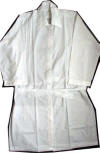 Kittel: The kittel, Yiddish for
robe, is a white garmet worn by mainly orthodox male
Jews on special occasions such as one's wedding day,
during the Rosh Hashanah and Yom Kippur prayer services,
and during the passover Seder. Kittel: The kittel, Yiddish for
robe, is a white garmet worn by mainly orthodox male
Jews on special occasions such as one's wedding day,
during the Rosh Hashanah and Yom Kippur prayer services,
and during the passover Seder. |
 Sheitel: Sheitel (pronounced Shi-tel
or Shay-tel) is a wig worn by Orthodox married Jewish
women in compliance with the covering head requirement,
related to the modest dress standard called tzeniut.
Orthodox Jewish law requires married women to cover
their hair, and wigs, caps, turbans, kerchiefs, scarves
are all acceptable Sheitel: Sheitel (pronounced Shi-tel
or Shay-tel) is a wig worn by Orthodox married Jewish
women in compliance with the covering head requirement,
related to the modest dress standard called tzeniut.
Orthodox Jewish law requires married women to cover
their hair, and wigs, caps, turbans, kerchiefs, scarves
are all acceptable |
 Shtreimel: The Shtreimel is a large
kippah encircled by pieces of fur. The shtreimel is
generally worn by Chassidic men only after marriage Shtreimel: The Shtreimel is a large
kippah encircled by pieces of fur. The shtreimel is
generally worn by Chassidic men only after marriage |
 Spodik: A spodik is a tall fur
hat worn similar to the Shtreimel but distictly
different in its size and height. The Spodik is worn by
specific mail Chasidic sect members usually of Polish
decent. The Ger Chassidus is most famous for this
particular head gear. Spodik: A spodik is a tall fur
hat worn similar to the Shtreimel but distictly
different in its size and height. The Spodik is worn by
specific mail Chasidic sect members usually of Polish
decent. The Ger Chassidus is most famous for this
particular head gear. |
 Tallit: The tallit (טַלִּית) also
called tallis is a prayer shawl worn during the
Shacharit morning prayers by married Jewish men. Men
wear the tallit also during the Torah reading services
and Shabbat and other holidays. It has special twined
and knotted fringes known as tzitzit attached to its
four corners. Tallit: The tallit (טַלִּית) also
called tallis is a prayer shawl worn during the
Shacharit morning prayers by married Jewish men. Men
wear the tallit also during the Torah reading services
and Shabbat and other holidays. It has special twined
and knotted fringes known as tzitzit attached to its
four corners.
|
 Tichel: The Tichel is a headscarf
worn by some Orthodox Jewish women in compliance with
the code of "tzniut" modest attire. The word "Tichel" is
Yiddish for "kerchief." There are lots of styles for
Tichels, from very plain to extremely elaborate designs
and fabrics. Tichel: The Tichel is a headscarf
worn by some Orthodox Jewish women in compliance with
the code of "tzniut" modest attire. The word "Tichel" is
Yiddish for "kerchief." There are lots of styles for
Tichels, from very plain to extremely elaborate designs
and fabrics. |
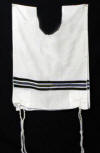 Tzitzit: The Tzitzit or Tzitzis
are "fringes" or "tassels" worn by observant Jews on the
corners of four-cornered garments, including the tallit
(prayer shawl). In Orthodox Judaism, they are worn only
by men however there are conservative women who choose
to wear the garmet as well.
Click here for examples of Tzitzit Tzitzit: The Tzitzit or Tzitzis
are "fringes" or "tassels" worn by observant Jews on the
corners of four-cornered garments, including the tallit
(prayer shawl). In Orthodox Judaism, they are worn only
by men however there are conservative women who choose
to wear the garmet as well.
Click here for examples of Tzitzit |
 Tzniut: Tzniut in Hebrew means
Modesty. Orthodox Judaism requires men and women
practice modesty of dress. This requirement is
understood by all orthodox folk, however the standards
vary as does the strictness and adherence. In Charedi,
ultra orthodox communities the men generally wear long
pants usually black and often long shirts (mostly white)
and women wear long-sleeve blouses and ankle-length
dresses, and the color schemes are more subdued and
sedate (no hot pinks). The lengths of sleeves, dresses,
and head covering varies... Tzniut: Tzniut in Hebrew means
Modesty. Orthodox Judaism requires men and women
practice modesty of dress. This requirement is
understood by all orthodox folk, however the standards
vary as does the strictness and adherence. In Charedi,
ultra orthodox communities the men generally wear long
pants usually black and often long shirts (mostly white)
and women wear long-sleeve blouses and ankle-length
dresses, and the color schemes are more subdued and
sedate (no hot pinks). The lengths of sleeves, dresses,
and head covering varies... |

How to Dress Jewish
Every Day?
Jewish T-Shirts,
Jewish Attire fitting for the Synagogue, Jewish School Clothes,
Modest attire for Jewish Women,
Israeli Apparel, Israel related T-Shirts, Shabbat Shoes, Jewish
Wedding Shoes.
How to Dress for
a Jewish Wedding?
Is a Tuxedo the
standard?
What about the Mother of the Jewish bride?
What do the
Jewish Bridesmaids wear?
What are Jewish Wedding Clothes appropriate for Jewish Children?
See information at
The Jewish Wedding Guide at
www.JewishCelebrations.com
How to dress for a
Bar Mitzvah?
Is a Tuxedo the
standard? What about the Mother of the Bar Mitzvah or Bat Mitzvah?
What are appropriate Bar Mitzvah or Bat Mitzvah Clothes for Jewish
Children?
See information at
The Jewish Wedding Guide at
www.JewishCelebrations.com
How to dress for a
Jewish Funeral?
Appropriate attire for
Jewish Funerals. Shall one wear black?
See information at
Death and Mourning in Jewish Traditions
www.Mazornet.com/deathandmourning
|
|





